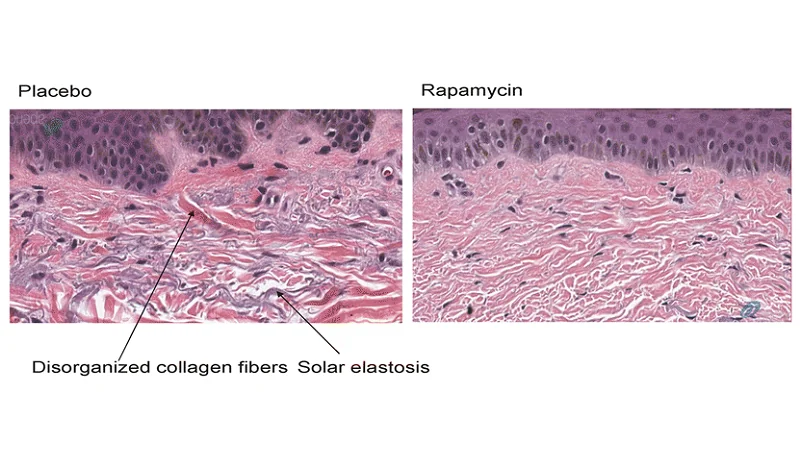The results of a small human clinical trial focused on skin aging have been published, and they are positive.
A topical application of rapamycin, an FDA-approved drug that is used to combat organ rejection during donor transplants and targets the mechanistic target of rapamycin (mTOR) pathway, was tested to see if it had any effect on skin aging.
mTOR is composed of the mTORC1 and mTORC2 protein complexes. It senses amino acids and is associated with nutrient abundance. It is a kinase, which means it adds phosphates to molecules. mTOR is a master regulator of anabolic metabolism, the process of building new proteins and tissues. mTOR is one of the four major pathways which control energy metabolism, and its deregulation is thought to be one of the reasons we age.
Thirty-six participants aged 40 years and over took part in the pilot study and were all chosen due to having signs of photoaging and loss of dermal volume; other than age-related damage to their skin, they were healthy.
The researchers observed that there was a significant decrease in the level of p16INK4A protein following treatment. This protein is typically secreted by senescent cells, which have reached their end of their useful lives or are damaged to the point that they can no longer replicate. Usually these cells enter a self-destruct process known as apoptosis and are disposed of by the immune system, but as we get older, an ever increasing amount of these cells go rogue and avoid this fate. Instead, they remain at large in the body and cause chronic inflammation and are also thought to be another reason we age.
If the presence of p16INK4A protein is falling as a result of treatment, this suggests that there has been a reduction of senescent cells; this could either be a case of them being removed properly by the immune system after entering apoptosis, as happens when we are younger, or that the cells themselves are experiencing a slower pace of aging and reaching senescence later. In either case, the reduction of p16INK4A-expressing cells is a positive thing for longevity, and in animal studies, this is known to lead to an increase of healthy lifespan and the delay of age-related diseases.
The researchers also observed an increase in collagen VII protein in the treated skin. Collagen VII is crucial for the integrity of skin and gives it support and structure; the level of collagen VII also falls as we age and contributes to the formation of wrinkles and other familiar signs of aging in skin.
The researchers suggest that these initial results show that rapamycin has potential in addressing skin aging in humans and could be developed for therapeutic use.
Aging is a major risk factor for the majority of human diseases, and the development of interventions to reduce the intrinsic rate of aging is expected to reduce the risk for age-related diseases including cardiovascular disease, cancer, and dementia. In the skin, aging manifests itself in photodamage and dermal atrophy, with underlying tissue reduction and impaired barrier function. To determine whether rapamycin, an FDA-approved drug targeting the mechanistic target of rapamycin (mTOR) complex, can reduce senescence and markers of aging in human skin, an exploratory, placebo-controlled, interventional trial was conducted in a clinical dermatology setting. Participants were greater than 40 years of age with evidence of age-related photoaging and dermal volume loss and no major morbidities. Thirty-six participants were enrolled in the study, and nineteen discontinued or were lost to follow-up. A significant (P = 0.008) reduction in p16INK4A protein levels and an increase in collagen VII protein levels (P = 0.0077) were observed among participants at the end of the study. Clinical improvement in skin appearance was noted in multiple participants, and immunohistochemical analysis revealed improvement in histological appearance of skin tissue. Topical rapamycin reduced the expression of the p16INK4A protein consistent with a reduction in cellular senescence. This change was accompanied by relative improvement in clinical appearance of the skin and histological markers of aging and by an increase in collagen VII, which is critical to the integrity of the basement membrane. These results indicate that rapamycin treatment is a potential anti-aging therapy with efficacy in humans.
Conclusion
A relatively low dose of rapamycin (10 μM, or 0.001%) is being used for this topical application, while far higher doses (0.1–1%) are used for the treatment of tuberous sclerosis complex (TSC) without serious side effects. In the treatment of TSC, the dose is designed to halt cell growth, but in this application, the dose is massively lower in order to aid healthy cell function without stopping cells from growing and replicating. This dose, therefore, presents a minimal risk to safety.
It is also worth noting that there are a number of other drugs that target mTOR, including several rapalogs, which are based on rapamycin but may be more efficient and with less off-target effects. It would be interesting to test those rapalogs using the same topical delivery approach to see if they are more or less effective at combating skin aging.
Unfortunately, as people are people and are harder to keep track of than mice, 19 participants dropped out of the study before it was completed. This is a shame but highlights why human studies should be as large as possible, as non-compliance and drop-outs are all too common. There were still a reasonable number of remaining participants, especially for an initial study like this, and the data presented here is valuable. We look forward to seeing a larger follow-up study that will hopefully further confirm the viability of topical rapamycin for skin aging.




